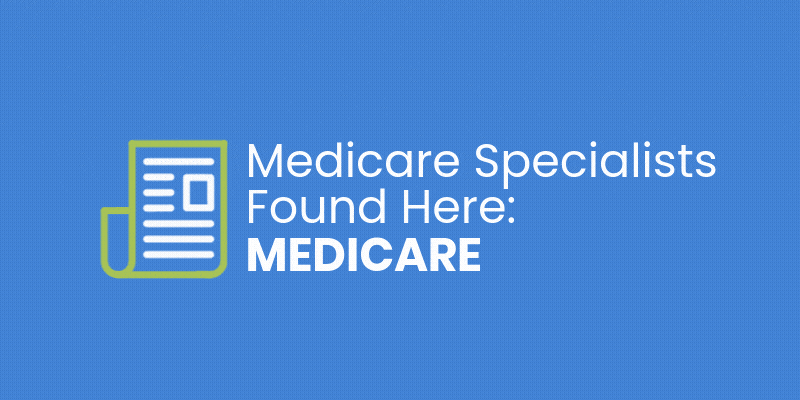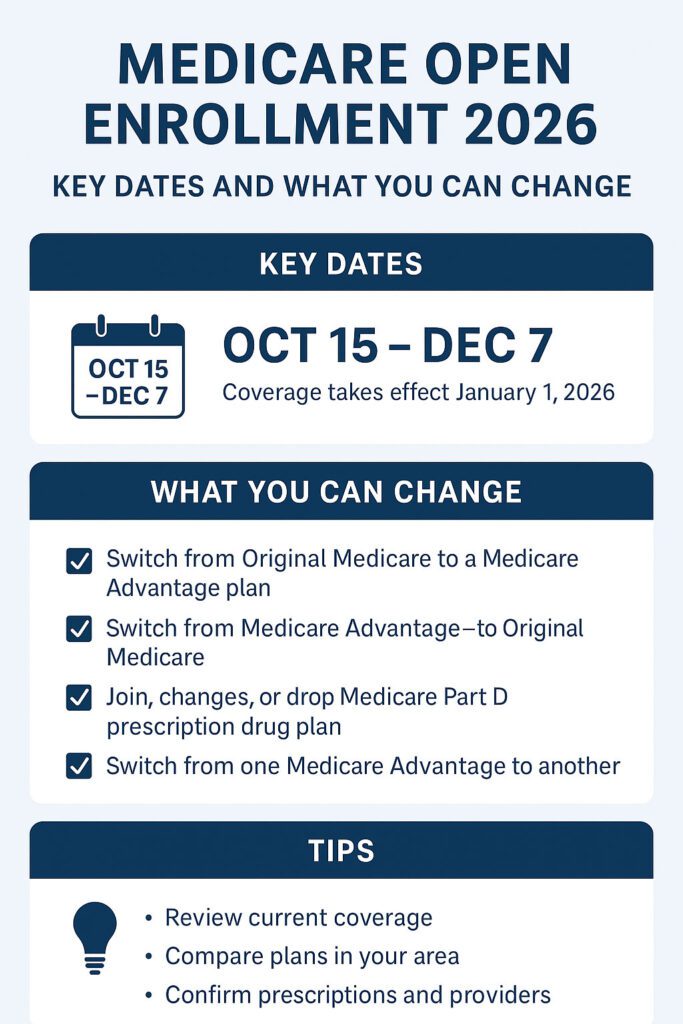Medicare Open Enrollment Starts Today: What You Need to Know

October 15 to December 7: Your Window to Make Changes
Today marks the start of Medicare’s Annual Election Period (AEP)—October 15 through December 7. During this time, beneficiaries can review and adjust health and prescription drug plans for the coming year.
Any changes you make now will go into effect January 1, 2026.
Missing this window could leave you stuck in a plan that’s no longer optimal—or paying higher charges in some cases.
What You Can Do During Open Enrollment
During this period, Medicare beneficiaries can:
- Switch from Original Medicare (Parts A & B) to a Medicare Advantage (Part C) plan (or vice versa)
- Enroll in, switch, or drop a Part D prescription drug plan (if you have Original Medicare)
- Change from one Medicare Advantage plan to another
- Drop Medicare Advantage and return to Original Medicare (noting supplemental coverage implications)
If you don’t take any action, your current coverage will generally automatically renew for 2026—unless your plan is discontinued or significantly changed.
What’s Changing in 2026 You Should Factor In
When comparing plans this year, don’t just look at premiums. Some of the key updates and cost shifts include:
- Higher Part B premiums and deductibles: The standard Part B premium is expected to rise to about $206.50, with the annual deductible increasing to around $288.
- Prescription drug changes: The out-of-pocket cap for Part D will increase to $2,100 (up from $2,000).
- Plan updates in Medicare Advantage and Part D: 2026 regulations affect formularies, prior authorizations, and provider networks.
- Automatic renewals: Many plans will renew automatically unless you opt out or switch.
Because of these shifts, a plan that looked good last year might not be the best fit now.

6 Steps to Help You Choose Wisely
1. Compare Your “Annual Notice of Change” (ANOC)
Each plan sends this document—review it carefully for cost, coverage, or provider network changes.
2. Use the Medicare Plan Finder Tool
The official Medicare.gov tool lets you compare plans side by side based on your prescriptions and providers.
3. Check Provider and Pharmacy Compatibility
Confirm that your doctors and preferred pharmacies remain in-network under any plan you consider.
4. Mind Prescription Drug Formulary Changes
Drug tiers and coverage rules can shift yearly—make sure your medications remain covered affordably.
5. Evaluate Out-of-Pocket Costs Holistically
Look beyond premiums to deductibles, copays, and coinsurance limits when comparing plans.
6. Seek Help if Needed
Free State Health Insurance Assistance Programs (SHIPs) and licensed professionals can help you navigate your options.
Why Acting Early Matters
- Popular plans can fill up or close to new enrollments.
- Late decisions create stress as the deadline nears.
- Avoid coverage gaps by allowing processing time before December 7.
Reviewing early gives you more time to make confident, informed choices.
Where This Ties Into Retirement Income Planning
Medicare isn’t just about healthcare—it’s a key part of your overall retirement income strategy. Choosing the right plan can protect your nest egg by lowering out-of-pocket costs and preventing unexpected expenses.
If rising Medicare costs or plan changes create an income gap, you may need to revisit your income sources—such as Social Security timing, annuities, or tax-efficient withdrawals—to keep your plan balanced.
Quick Reference: What You Can Do During Open Enrollment
| Action | Why It Matters |
|---|---|
| Review your current plan’s changes | Some plans shift benefits or raise costs each year |
| Compare new plans in your area | You may find better value or improved drug coverage |
| Confirm your doctors and prescriptions | Avoid disruptions in your care or pharmacy access |
| Enroll early | Prevents processing delays or coverage gaps |
| Get professional or SHIP help | Trained counselors can help avoid costly mistakes |
Final Thoughts
Medicare Open Enrollment begins today. Don’t let this opportunity pass by. With premiums, networks, and coverage details changing for 2026, now is the time to review your options.
Take a few minutes to compare your plan, confirm your doctors and prescriptions, and make any necessary adjustments before December 7. Small actions now can prevent big costs later—and help protect both your health and your financial future.
Sources: Centers for Medicare & Medicaid Services (CMS), National Council on Aging (NCOA), Medicare.gov, Medicare Resources, PAN Foundation, NerdWallet, Investopedia, Kiplinger
Disclaimer: This article is for educational and informational purposes only. It is not medical, legal, or financial advice. Please consult licensed professionals about your specific Medicare, insurance, or retirement situation. SafeMoney.com is not affiliated with or endorsed by any government agency.








